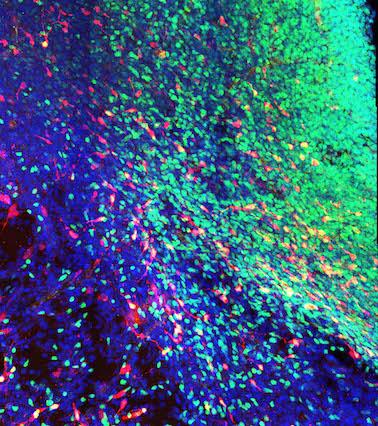Interneurons find their way to the striatum

MGE-derived interneurons are shown expressing EphB3 (red) and Nkx2-1 (green) migrating to the striatum. Credit: Verona Villar-Cerviño, PhD Instituto de Neurociencias (CSIC-UMH)
These results, published in Journal of Neuroscience in collaboration with investigators from the Instituto de Neurociencias in Alicante (Spain), also reveal the molecule nature of the cues regulating the migration of striatal interneurons.
During development, the medial ganglionic eminence (MGE), a transitory brain structure, produces several populations of GABAergic inhibitory neurons, including cortical and striatal interneurons.
While most research studies have focused on the migration of interneurons to the cortex, very little is known about the mechanisms through which interneurons colonise the striatum. Both cortical and striatal interneurons can be attracted by Nrg1 sources present in the cerebral cortex and the striatum.
Therefore, the segregation of these two populations of interneurons must depend on repulsive signals that prevent the colonization of regions outside their final target.
Experiments carried out by the group of Prof. Marín demonstrated that striatal interneurons are repelled by the cerebral cortex through a mechanism that involves Eph/ephrins signalling.
This new study also showed that responsiveness of MGE-derived striatal interneurons to attractive and repulsive cues is at least in part controlled by the postmitotic activity of the transcription factor Nkx2-1. These results reveal parallel mechanisms of target chemoattraction and off-target chemorepulsion for the migration of interneurons to the cortex and striatum.
###
This work was supported by grants from the Spanish Ministry of Economy SAF2011- 28845 and CONSOLIDER CSD2007-00023.
Original publication: Villar-Cerviño V., Kappeler C., Nóbrega-Pereira S., Henkemeyer M., Rago L., Nieto MA. & Marín O. (2015) Molecular Mechanisims Controlling the Migration of Striatal Interneurons. J Neurosci, in press.
For further information please contact Andreia Carvalho, Head of Scientific Affairs, MRC Centre for Developmental Neurobiology, King's College London (andreia.carvalho@kcl.ac.co.uk)
Media Contact
All latest news from the category: Life Sciences and Chemistry
Articles and reports from the Life Sciences and chemistry area deal with applied and basic research into modern biology, chemistry and human medicine.
Valuable information can be found on a range of life sciences fields including bacteriology, biochemistry, bionics, bioinformatics, biophysics, biotechnology, genetics, geobotany, human biology, marine biology, microbiology, molecular biology, cellular biology, zoology, bioinorganic chemistry, microchemistry and environmental chemistry.
Newest articles

Superradiant atoms could push the boundaries of how precisely time can be measured
Superradiant atoms can help us measure time more precisely than ever. In a new study, researchers from the University of Copenhagen present a new method for measuring the time interval,…

Ion thermoelectric conversion devices for near room temperature
The electrode sheet of the thermoelectric device consists of ionic hydrogel, which is sandwiched between the electrodes to form, and the Prussian blue on the electrode undergoes a redox reaction…

Zap Energy achieves 37-million-degree temperatures in a compact device
New publication reports record electron temperatures for a small-scale, sheared-flow-stabilized Z-pinch fusion device. In the nine decades since humans first produced fusion reactions, only a few fusion technologies have demonstrated…





















